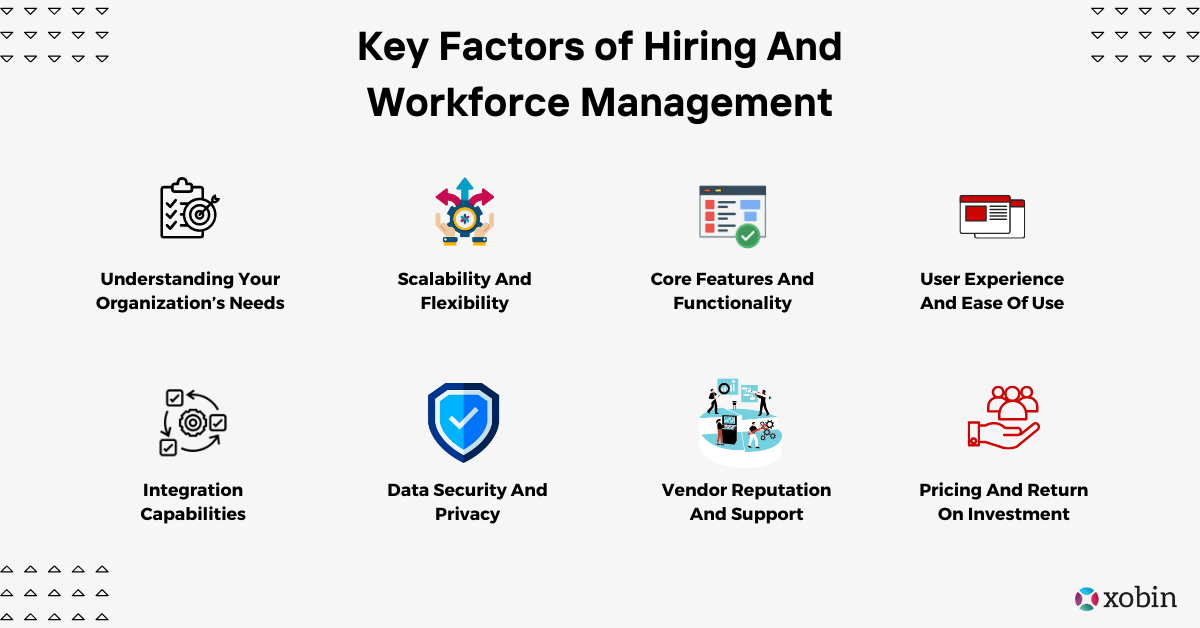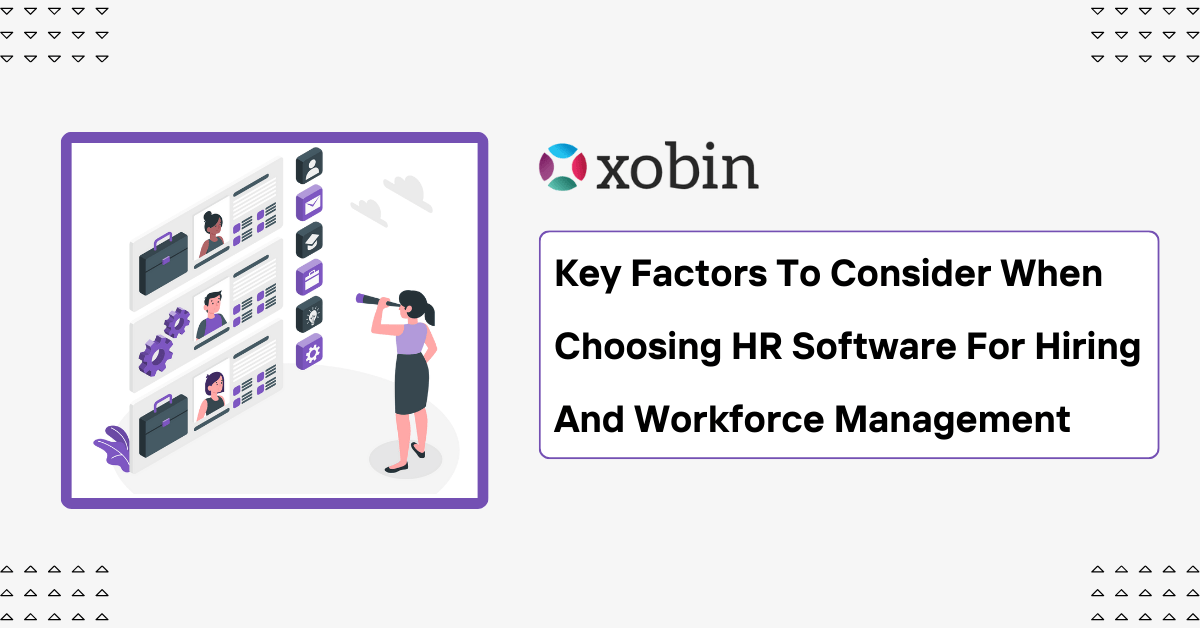HR software has become the backbone of modern business, particularly in facilitating efficient hiring and effective workforce management. It streamlines HR tasks, reduces administrative burdens, and enables better data-driven decision-making. With solutions like Xobin’s Applicant Tracking Software, businesses can automate hiring, enhance recruitment accuracy, and ensure seamless workforce management.
This blog post aims to help you make an informed decision when choosing HR software tools, addressing key factors you need to consider in your selection process.
Table of Contents
Challenges in Hiring and Workforce Management
Hiring and workforce management is a critical task for any organization. However, it comes with a set of challenges that can impact productivity, employee satisfaction, and overall business success. In this section, we will explore some of the common challenges faced by businesses in hiring and workforce management, along with potential solutions to address them effectively.
Talent Acquisition and Recruitment Challenges
Finding skilled and qualified candidates in a talent shortage can be a significant hiring challenge for organizations. Let me take you through these challenges:
- Talent shortage: Finding skilled and qualified candidates for specific roles can be a significant challenge, especially in competitive industries or niche skill sets.
- Time-consuming recruitment process: The hiring process often involves multiple stages, from sourcing candidates to conducting interviews and assessments, which can be time-consuming and delay filling vacant positions.
- Employer branding: Establishing and promoting a strong employer brand to attract top talent can be challenging, particularly for smaller or lesser-known organizations.
Employee Retention and Engagement Challenges
High demands of employee satisfaction and retention are one of the top challenges HR’s are facing in workforce management. Below we have listed 3 such challenges:
- High employee turnover: Retaining top-performing employees can be a struggle, leading to increased recruitment and training costs.
- Employee disengagement: Disengaged employees can result in decreased productivity, low morale, and a negative work environment.
- Work-life balance: Balancing work demands with employees’ personal lives is essential for their well-being and job satisfaction.
Skills Development and Training Challenges
With evolving skill requirements, businesses face challenges in providing timely training and development opportunities for employees. Limited training resources and knowledge transfer from experienced employees pose additional hurdles.
- Evolving skill requirements: The rapid pace of technological advancements often requires employees to update their skills constantly, which can be challenging for businesses to manage and provide adequate training.
- Limited training resources: Smaller businesses may have limited budgets and resources to invest in employee training and development programs.
- Knowledge transfer: Retaining institutional knowledge and effectively transferring it to new employees can be a challenge, particularly when experienced employees leave the organization.
Workforce Diversity and Inclusion Challenges
Overcoming biases in hiring and promotion processes is essential to ensure equal opportunities for all candidates. Creating an inclusive work environment that values diversity and inclusion treats employees equally is a complex task.
- Bias in hiring and promotion: Overcoming unconscious bias in recruitment and ensuring equal opportunities for all candidates can be a significant challenge.
- Creating an inclusive work environment: Fostering an inclusive workplace culture that values diversity and promotes equal treatment for all employees can be a complex task.
Workforce Planning and Flexibility Challenges
Forecasting future workforce needs accurately can be challenging, especially during periods of growth or downsizing. Balancing workforce flexibility, such as remote work or flexible schedules, with maintaining stability and meeting business goals requires careful navigation.
- Forecasting workforce needs: Accurately predicting future workforce requirements and planning accordingly can be challenging, particularly in dynamic industries or during periods of growth or downsizing.
- Balancing flexibility and stability: Balancing the need for workforce flexibility, such as remote work or flexible schedules, with maintaining stability and meeting business goals can be a delicate balancing act.
Addressing the challenges in hiring and workforce management is crucial for organizations to attract top talent, retain employees, and drive overall business success. By recognizing and proactively finding solutions to these challenges, businesses can build a strong and engaged workforce, enhance productivity, and create a positive work environment.
Key Factors of Hiring And Workforce Management

Understanding Your Organization’s Needs
The first step is to assess your organization’s current hiring processes and identify any pain points in your workforce management. Conduct thorough market research on HR software user experience to gain insights into potential solutions to your problems. Next, define areas for improvement – these could range from applicant tracking to employee performance evaluation.
Finally, set your goals and objectives for future growth. Your chosen software should align with these goals, helping you achieve them efficiently.
Scalability And Flexibility
HR software must grow with your business. In order to grow they should evaluate potential software’s scalability – can it accommodate more users, data, or functionalities as your organization grows? Consider also its flexibility. Will it adapt to changing needs? Could it integrate with new tools you might adopt in the future?
These considerations are vital to ensure your chosen software remains useful in the long run.
Core Features And Functionality
Effective software for hiring and workforce management should have robust features. A well-rounded system should offer an applicant tracking system, job posting, and candidate screening functionalities for efficient recruitment management. It should streamline the onboarding process, track time and attendance, and provide a framework for performance management.
Additional features might include managing employee training programs, tracking progress, and ensuring compliance with regulatory requirements.
User Experience And Ease Of Use
An intuitive interface is key for user adoption. Look for software that offers straightforward navigation and mobile accessibility for on-the-go management. Customization options are also valuable, allowing you to tailor the software to your organization’s unique needs. Moreover, consider the vendor’s user support and training resources – these can greatly aid in successful software deployment.
Integration Capabilities
When selecting HR software for your organization, it’s important to evaluate the tool’s integration capabilities. This factor is often overlooked but holds significant importance for smooth operations. The software should be able to coexist harmoniously with your existing systems, tools, and technologies. This compatibility is essential to ensure you don’t have to make wholesale changes to your existing IT infrastructure, saving you time, money, and resources.
Furthermore, seamless data integration and synchronization should be a fundamental feature of your chosen HR software. It needs to ensure that data is efficiently shared and updated across various HR functions, providing a unified and consistent overview of your workforce. This functionality is vital for creating synergies between different HR areas, such as recruitment, onboarding, training, and performance management.
Additionally, the accessibility of data across different HR functions should not be underestimated. In a well-integrated system, data entered in one area should be instantly available for use in other areas. This reduces redundant data entry, increasing efficiency, and ensures decision-making is informed by the most current data. Therefore, an integrated system also makes it easier to generate comprehensive reports, offering valuable insights into your HR operations.
Data Security And Privacy
Data security and privacy have become hot-button issues in the digital world. When choosing HR software, it’s crucial to thoroughly evaluate the platform’s security measures. This evaluation should extend beyond the basic protection systems. You should consider if the software incorporates advanced security technologies, such as encryption and multi-factor authentication. These measures will help safeguard your sensitive hiring and workforce management related HR data against cyber threats. Also, your chosen HR software should comply with the latest data protection regulations. In an increasingly globalized business world, these may include not just domestic laws, but also international regulations like the EU’s General Data Protection Regulation (GDPR). Non-compliance could lead to severe legal penalties, so it’s essential to ensure your software vendor is aware of and meets these requirements.
Additionally, another important aspect to look into is the software’s data backup and disaster recovery mechanisms. Data loss could have catastrophic consequences for your business. Therefore, your HR software should regularly back up data to a secure location, from where it can be easily restored in case of any data loss incidents. Moreover, the vendor should have a disaster recovery plan in place, which includes measures to minimize data loss and downtime and procedures to restore normal operations as quickly as possible after a disaster.
Vendor Reputation And Support
A reputable vendor with positive reviews and testimonials will give you peace of mind. Assess the quality of their support services, including technical support and training resources. Their track record and industry experience can be indicative of their reliability and commitment to client satisfaction.
Pricing And Return On Investment (ROI)
Understanding the pricing structure is crucial – some vendors offer one-time fees, while others use subscription-based or per-user pricing. Evaluating the ROI potential of the software will ensure that it provides value in terms of time and cost savings. Don’t forget to calculate the long-term benefits – good software is an investment.
Conclusion
In conclusion, selecting the right HR software requires thorough evaluation and research. From understanding your organizational needs to assessing vendor reputation, various factors come into play. Remember to prioritize your unique needs and objectives throughout this process.
For further assistance, explore our curated list of reputable HR software vendors. Share your experiences and questions in the comments section – we value your input. For future insights and updates on HR technology, consider signing up for our newsletter or following this blog. Your journey to effective hiring and workforce management starts here.






